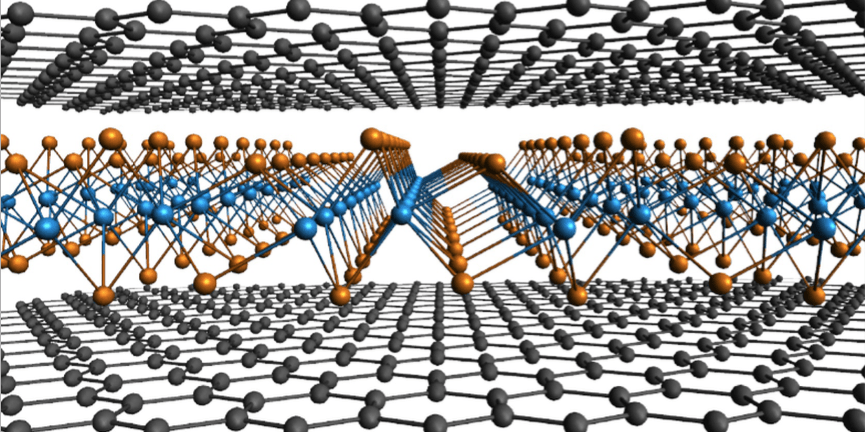Feb 9 2017
For the first time, scientists from the University of Pennsylvania have produced a single, three-atom-thick layer of a distinctive two-dimensional (2D) material known as tungsten ditelluride. The outcomes of the research have been reported in the 2D Materials journal.
 A ball and stick model of the graphene-tungsten ditelluride-graphene stack used for imaging in the research. (Credit: http://www.upenn.edu/)
A ball and stick model of the graphene-tungsten ditelluride-graphene stack used for imaging in the research. (Credit: http://www.upenn.edu/)
Researchers are convinced that tungsten ditelluride, in contrast to 2D materials, has the so-called topological electronic states, suggesting that it can have not just one but many different characteristics.
Graphene is perhaps the material that immediately comes to mind when one thinks about 2D materials.
Graphene is a tightly packed, atomically thin sheet of carbon that was first produced in the year 2004. Since then it has influenced countless research avenues, thereby transforming everything from technology to drinking water.
The most significant characteristic of graphene is that it is a so-called zero bandgap semiconductor, i.e. it can conduct itself a metal as well as a semiconductor.
However, there are many other characteristics that can be possessed by 2D materials, i.e. certain materials can emit light, others can insulate, and still others can behave as a spintronic, or having magnetic properties.
Graphene is just graphene. It just does what graphene does. If you want to have functioning systems that are based on 2D materials, then you want 2D materials that have all of the different physical properties that we know about.”
A. T. Charlie Johnson, physics professor from the Penn’s School of Arts & Science
Charles Kane, the Christopher H. Browne Distinguished Professor of Physics at Penn, pioneered the 2D materials’ potential to have topological electronic states.
In this study, the characteristics of a single layer of tungsten ditelluride were produced and measured by Johnson, physics professor James Kikkawa, and graduate students Carl Naylor and William Parkin.
Because tungsten ditelluride is three atoms thick, the atoms can be arranged in different ways. These three atoms can take on slightly different configurations with respect to each other. One configuration is predicted to give these topological properties.
Johnson
Other researchers who contributed to the study were Marija Drndić, the Fay R. and Eugene L. Langberg Professor of Physics; Andrew Rappe, the Blanchard Professor of Chemistry and a professor of materials science and engineering in the School of Engineering and Applied Science; and Robert Carpick, the John Henry Towne Professor and chair of the Department of Mechanical Engineering and Applied Mechanics.
It’s very much a Penn product. We’re collaborating with multiple other faculty members who investigate the material in their own ways, and we brought it all together to put a paper out there. Everybody comes along for the ride.
Johnson
To successfully grow this material, the researchers employed a technique known as chemical vapor deposition, which involves heating a chip containing tungsten to the optimum temperature by means of a hot-tube furnace, and then introducing a vapor comprising of tellurium.
Through good fortune and finding exactly the right conditions, these elements will chemically react and combine to form a monolayer, or three-atom-thick regions of this material.
Johnson.
In spite of the fact this material gets degraded in a highly rapid fashion in the presence of air, the paper’s first author, Naylor, deduced methods to safeguard the material such that it can be analyzed before being degraded.
One main discovery that the researchers found was that the material was grown in little rectangular crystallites, in contrast to other materials that grow as triangular crystallites.
This reflects the rectangular symmetry in the material. They have a different structure so they tend to grow in different shapes.
Johnson
Despite the fact that the research is only in its starting stages and the scientists have not been able to successfully produce a continuous film, they anticipate to carry out experiments to demonstrate that the material has the predicted topological electronic properties.
One main characteristic of such topological systems is that any current traversing in the material is carried only on the edges, and no current traverses through its center. Upon successful synthesis of single-layer-thick materials with this characteristic, the researchers might be able to direct an electrical signal to get branched toward different locations.
The potential of this material to have multiple characteristics can also have positive consequences in the field of quantum computing, which involves exploiting the power of atoms as well as subatomic phenomena to carry out calculations remarkably faster when compared to prevalent computers. These 2D materials can provide a path for an intrinsically error-tolerant form of quantum computing known as topologically protected quantum computing, which necessitates semiconducting as well as superconducting materials.
With these 2D materials, you want to realize as many physical properties as possible. Topological electronic states are interesting and they’re new and so a lot of people have been trying to realize them in a 2D material. We created the material where these are predicted to occur, so in that sense we’ve moved towards this very big goal in the field.
Johnson
Grants from the National Institute of Health, National Science Foundation, and the federal Department of Energy supported the research.